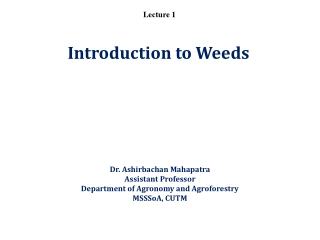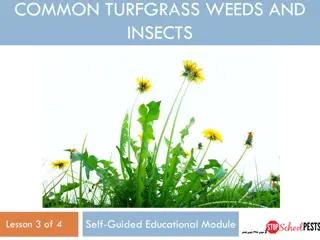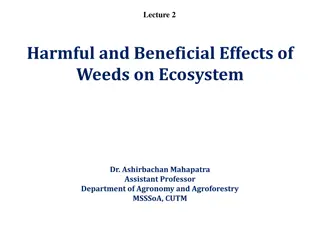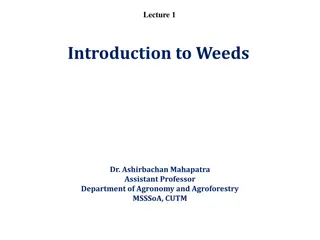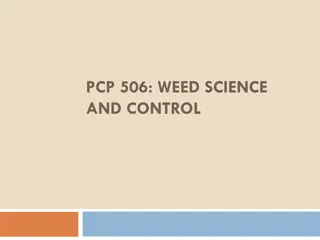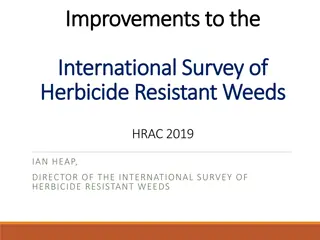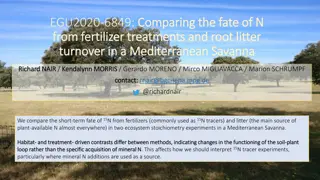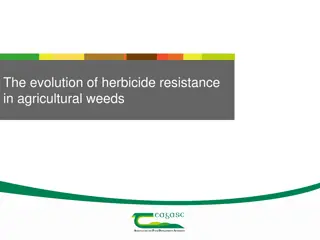Understanding Harmful and Beneficial Effects of Weeds on Ecosystem
Weeds in agriculture have a significant impact, accounting for 45% of annual crop loss in India. They compete with crops for resources, reduce yield, and affect quality. Additionally, weeds can complicate farming practices, hinder harvesting, and lower the value of land. It is crucial to manage weed infestations to mitigate their detrimental effects on agriculture, livestock, human health, and ecosystems.
Download Presentation

Please find below an Image/Link to download the presentation.
The content on the website is provided AS IS for your information and personal use only. It may not be sold, licensed, or shared on other websites without obtaining consent from the author. Download presentation by click this link. If you encounter any issues during the download, it is possible that the publisher has removed the file from their server.
E N D
Presentation Transcript
Lecture 2 Harmful and Beneficial Effects of Weeds on Ecosystem Dr. Ashirbachan Mahapatra Assistant Professor Department of Agronomy and Agroforestry MSSSoA, CUTM
Harmful and beneficial effects of weeds Harmful effects of weeds Of the total annual loss of agricultural produce from various pests in India, weeds account for 45%, insects 30%, diseases 20% & others 5%. The losses due to weeds depends on 1. Type of weed 2. Severity of Infestation 3. Duration of infestation 4. Competitive ability of the crop plants with weeds 5. Climatic conditions which effect the growth of the crop and the weed The harmful effects of weeds on various activities of human beings, crops, livestock and related aspects are: 1. Weed menace in agriculture 2. Weed menace in animal husbandry 3. Weed menace to human health 4. Weed menace to aquatic ecosystems 5. Weed menace to forest and pasture land 6. Weeds as alternate hosts to crop pests and diseases 7. Weeds reduce land value. 8. Weeds limits choice of crops
1. Weed menace in agriculture Reduction of crop yield has a direct correlation with weed competition. Weeds compete for water, light, nutrients and space. Weeds compete for water in dry land and for nutrients in irrigated crops. It includes reduction in crop yields and production efficiency and erosion of crop quality. varies from 34.3% to 89.8% depending upon the crop. Reduction in crop yields and production efficiency is direct effect due to weeds. It Crops Rice Wheat Maize, Sorghum, Pulses, Oilseeds Sugarcane Cotton Sugarbeet Onion Yield Loss (%) 30-35 15-30 18-85 38.8 47.5 48.4 90.7
Beside the direct reduction in crop yields there are many indirect ways by which the weeds may be troublesome in agriculture. For example: Weedy fields management practices become cumbersome. Harvest may be difficult when the field is invade with wild safflower (Carthamus oxycantha), Canada thistle (Cirsium arvense), cocklebur (Xanthium strumarium). Cowhage (Mucuna pruriens) cause itching to the labour. Harvesting becomes troublesome when the field bindweed (Convolvulus arvensis) and morning glory (Ipomoea sp) bind the crop plants together. The weeds at harvest may increase the excessive wear and tear of the farm machines and there by increased the cost of production to separate the weed seeds from the grain and other farm produce Weeds may reduce the quality of farm produce in many ways. In dry land agriculture weeds cause severe moisture stress and force the food grains to shrivel. The vegetables and fruits are discloured and deshaped in the presence of weeds. Contamination of food grains with poisonous weed seeds fetches low price. Foundation or certified seed is rejected if weed seeds exceed 2% and also the market value is reduced. The quality of the sugarcane crop is also reduced due to the presence of the parasitic weed Striga litura. Leaves of loranthus (Dendrophthoe falcate) impair the quality of tea. Leaves of Mikania micrantha create problem in tea plantation. In cotton the dry weed fragments adhere to the lint and hinder its spinning process.
In India Cocklebur (Xanthium srtumarium)reduce the quality of wool in sheep. Oil quality of mint was impaired by Cirsium arvense (Canada thistle). Land unsuitable for economic crop production when land infested with Cyperu rotundus, Cynadon dactylon. Thousands of hectare of cultivable area in rice growing regions of India have been abandoned or not being regularly cultivated due to severe infestation of nutgrass (Cyperus rotundus) and other perennial grasses. Crops differ in their ability to compete with weeds. In many instances, the presence of a particular weed in the field limits the choice of crops to be grown. Heavy weed infestation renders some economically important crops, particularly pulses, Vegetables, Cotton, Jute and forage crops unsuitable or less suitable for cultivation. In rice crop Echinochloa and Panicum act as alternate host for stem borer, whereas in maize, Chenapodium album acts a host for stalk borer and beetles & cut worms in case of tomato. Crotalaria spp. act as a main host for hairy caterpillar which effect castor crop. Wild mustard act as alternate host for club root/ black leg along with cabbage, cauliflower and for stem rust wild oats as alternate host which is major disease of wheat, oat, barley.
2. Weed menace in animal husbandry Milk gives odd smell when animal fodder crops are mixed with wild onion and wild garlic, Cichorium intybus, Argemone mexicana. Certain weeds cause sickness and death of animals due to high levels of alkaloids, tannins, oxalates, glucosites or nitrates. Death of herds of sheep occurs due its high oxalate content of Halogeton (H. glomeratus). It is dominant weed of arid and semi arid region. Leaves of lantana cause acute photosensitivity and jaundice in animals due to the toxic principle of Lantradene . Puncture vine (Tribulus terrestris) a weed of dryland induces extra sensitivity to light in sheep and puncture of the animal skin. In Kashmir, Rhododendron causes diarrhoea and shows blood strains in milk. Crotalaria spp. is fatal to chick where as sweet clover (Melilotus alba) contains dicumarin which act as anti blood coagulant.
3. Weed menace to human health Hay fever and asthma aggravated by pollens of Ambrosia artemissifolia. Parthenium hysterophous, Poison ivy (Rhus sp), common rag weed (Ambrosia artemissifolia) are responsible for respiratory problems and skin allergies (dermatitis). Aquatic weeds like water lettuce (Pistia lanceolata), salvinia (Salvina auriculata), alligator weed (Alternanthera sp) act as alternate host and vectors of malaria, yellow fever, encephalitis, dengue fever and filariasis. Wheat flour contaminated with seeds of cocklebur (Xanthium strumarium) gives bitter taste to the bread and irritates the gastric tract of the consumer. When the Mexican poppy seeds (Argemene mexicana) crushed with mustard seeds cause death and blindness of people. Milk from animals feed on the Mexican poppy weed can cause Glaucoma in humans. The Argemone toxicity is due to an alkaloid called Sanguinarine and 11- oxotriacontanoic acid.
4. Weed menace to aquatic ecosystems Aquatic weeds make the appearance of water bodies repulsive and decline their recreational value. Weeds hinder the navigation, fishing and slow down the flow in irrigation channels. Aquatic weeds upon decomposition emit offensive odors and pollute the drinking water bodies. 5. Weed menace to forest and pasture lands In Karnataka and Andhra Pradesh, large forest area come under the grip of Parthenium hysterophorus. In West Bengal, 11% of high forest area and 38% of plantation forest have been affected by Mikania micrantha (mile-a-minute weed).
Beneficial effects of weeds or economic uses of weeds Several weeds have been put to certain economic uses since ages. Typha and Saccharum sp used for making ropes and thatch boards. Cichorium intybus roots are used for adding flavor to coffee powder. Amaranthus viridis, Chenopodium album and Portulaca sp. used as leafy vegetable. In north India Saccharum spontaneum used in breeding programme for developing the noble canes. Incorporation of Crotalaria, Parthenium, Calotropis and Eichornia reduced root knot nematode population in the soil as they exhibited nematicidal properties. Hariyali grass (Cynodon dactylon) and Cenchrus ciliaris, Dichanthium annulatum, Eclipta alba weeds of grass land serve as food for animals. People in china and Japan consume Chlorella pyrenoides (algae) as protein supplement. Weeds act as alternate host for predators and parasites of insect pests which feed on the weeds. For example Trichogramma chilonis feed upon eggs of caster semi looper which damage the castor plants. Some weeds useful to identify the metals (Indicator geobotany) through satellite imageries Eg Commelina sp, Ocimum centraliafricanum (Copper), Eichornia crassipes (Copper Zinc, lead and cadmium in water bodies. Several species of weeds Tephorsia purpurea and Croton sparsiflora in South India used as green manures. Whereas, Eichornia crassipes and Pistia stratiotes are used for composting.
Argemone mexicana used for reclamation of alkali soils. NO2 and SO2 air pollutiondetermined by wild mustard (Sinapis arvensis) and chick weed (Stellaria media) respectively. Aquatic weeds are useful in paper, pulp and fiber industry. Chenopodium album used as mulch to reduce evaporation losses, where as Agropyron repens (Quack grass) used to control soil erosion because of its prolific root system. Weeds like Lantana camera, Amaranthus viridis, Chenopodium albu, Eichhornia crassipes used for beautification. Agropyron repense used for soil conservation, where as Dicanthium annulatum stabilizing field bunds. Opuntia dellini used as biological fence. Some weeds have medicinal properties and used to cure snake bite (Leucas aspera), gastric troubles (Calotropis procera), skin disorders (Argemone mexicana) and jaundice (Phyllanthus niruri) and Striga orobanchioides to control diabetes. In addition to the above agarbathis (Cyperus rotundus), aromatic oils (Andropogan sp & Simbopogon sp) are prepared from weeds.
Beneficial effects of weeds or economic uses of weeds Several weeds have been put to certain economic uses since ages. S. N. 1 Purpose Associated weed names Ropes and thatch boards are prepared from Used to add flavor to coffee Used as leafy vegetable Used in breeding programme for developing the noble canes Have nematicidal properties Used as food for animals Typha and Saccharum sp. 2 3 4 Cichorium intybus Amaranthus viridis, Chenopodium album and Portulaca sp Saccharumspontaneum 5 6 Crotalaria, Parthenium, Calotropis and Eichornia Cynodondactylon (Hariyali grass) and Cenchrusciliaris, Dichanthiumannulatum, Ecliptaalba Chlorellapyrenoides (Algae) 7 People in Japan use as protein supplement Alternate host for predators and parasites of insect pests which feed on the weeds Metal identifier (Indicator geobotany) Commelina sp., Ocimumcentraliafricanum (Copper), Eichornia crassipes (Copper, Zinc, Lead and Cadmium in water bodies) Used as green manures in South India Tephrosia purpurea and Croton sparsiflora Used for composting Eichornia crassipes and Pistia stratiotes 8 Trichogramma chilionis feed upon eggs of caster semi looper which damage the castor plants 9 10 11
S. N. 12 13 14 15 Purpose Associated weed names Used for reclamation of alkali soils NO2 air pollution determination SO2 air pollution determination Used for preparation of paper, pulp and fiber industry Acts as a mulch to reduce evaporation Controls soil erosion because of its prolific root system (Hence uses in soil conservation) Used in beautification Argemone mexicana Sinapis arvensis (Wild mustard) Stellaria media (Chick weed) Aquatic weeds like Cyperus digitatus, Cyperus halpan, Cyperus rotundus, Scirpus grossus, and Typha angustifolia Chenopodium album 16 17 Agropyron repens (Quack grass) 18 Lantana camara, Amaranthus viridis, Chenopodium album, Eichhornia crassipes Dicanthium annulatum Opuntia dillenii Leucas aspera Calotropis procera Argemone mexicana Phyllanthus niruri Striga orobanchioides Cyperus rotundus Andropogan sp. and Simbopogon sp. 19 20 21 22 23 24 25 26 27 Stabilizes the field bunds Used as biological fence Used to cure snake bite Used to cure gastric troubles Used to cure skin disorders Used to cure jaundice Used to control diabetes Used to prepare agarbathis Used to prepare aromatic oils


